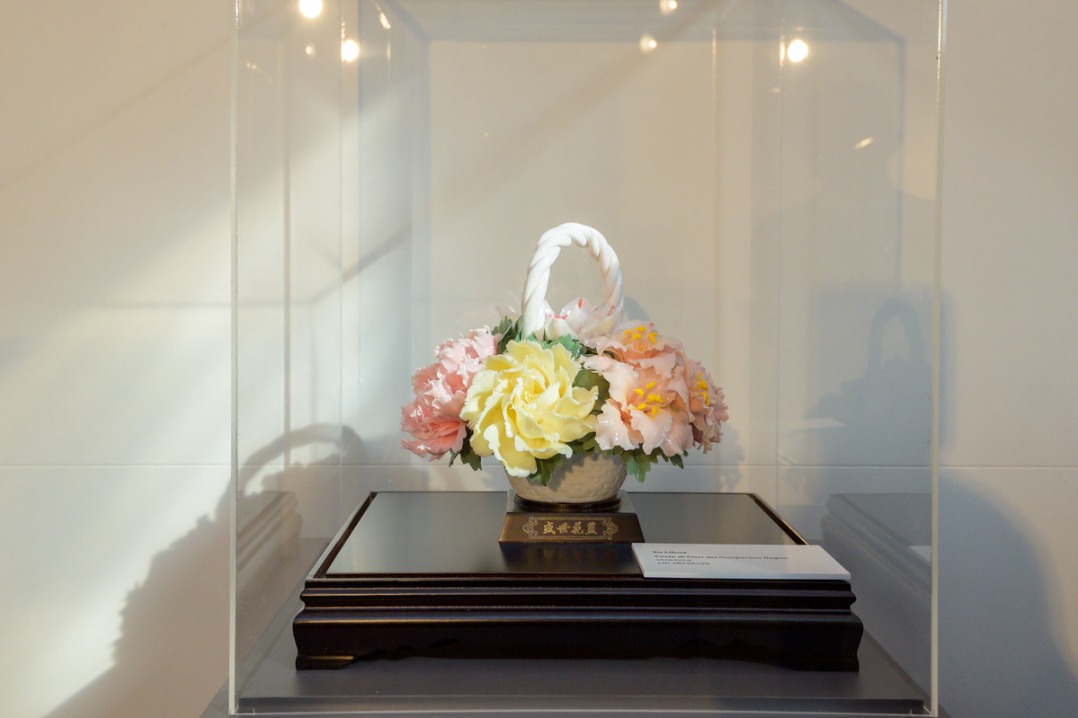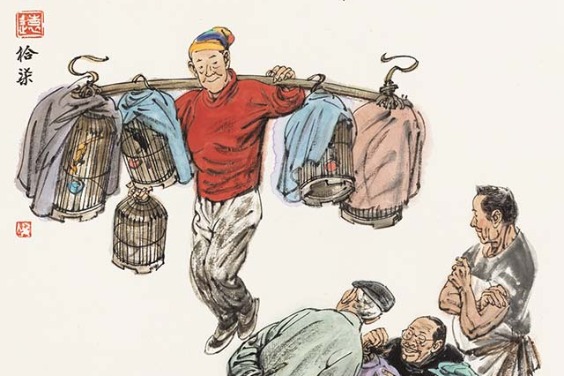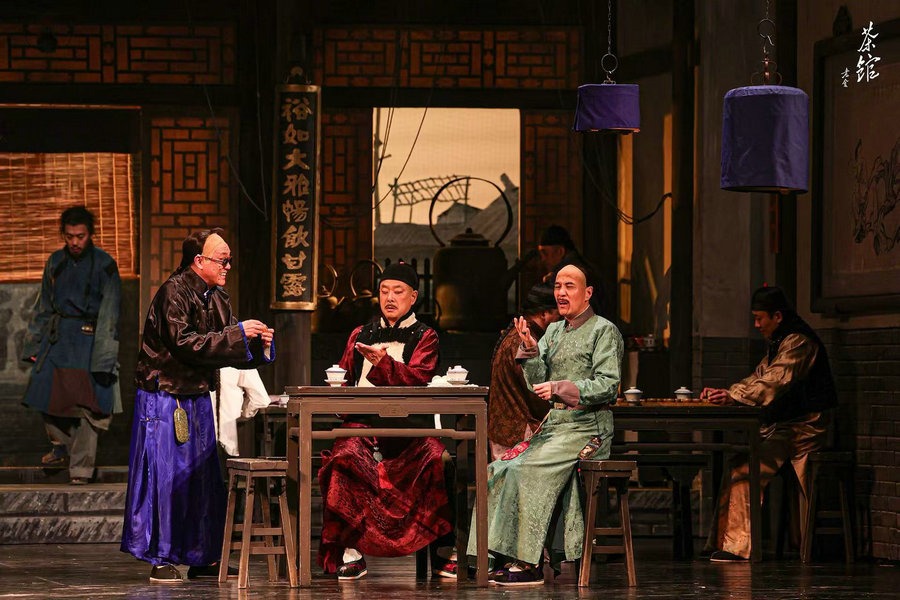Growing popularity of 'China Chic' offers a new twist on nation's ancient culture


Designers and artists are bringing fresh vitality to the country's history and folklore. Deng Zhangyu reports.
It was 10 pm on a winter night last month. Zhang Lingling dressed herself in a light hanfu-a type of dress worn by the ancient Han people-to attend a party with similarly attired friends in a KTV room.
They sang songs that were either accompanied by traditional instruments or had lyrics inspired by ancient poems.
The 23-year-old holds this kind of party at least once a month to share hanfu and popular traditional-style songs with her friends. Her latest hanfu cost 5,000 yuan ($790), more than half her monthly salary.
In addition to traditional-style clothes and music, Zhang spends more than an hour every day playing a mobile game that features a martial arts world full of traditional cultural elements.
Last year, the nurse at a private hospital in Southwest China's Chongqing spent about 20,000 yuan to make her character in the game look beautiful.
"I'm really attracted by clothes, songs and games themed on traditional culture. I'm not buying the items just because they are Chinese-they just satisfy my aesthetic needs," she said.
Booming trend
According to a report on the traditional culture trend in 2021, released on Feb 3 by Bilibili, an online video-sharing platform popular among younger people, more than 177 million of the platform's users were in favor of videos featuring traditional culture.
That approval reflected the way the "China Chic" phenomenon has been warmly embraced by the younger generation in recent years.
China Chic, or guochao, features fancy designs mixed with elements from traditional culture. It became widely known in 2018 after the sportswear brand Li-Ning took the fashion world by storm with its oriental-style designs at New York Fashion Week. That led to a growing number of Chinese brands joining the trend and creating a wave of China Chic.
"When we talked about China Chic several years ago, it was just a kind of consumption trend created by brands. However, it has evolved into a cultural phenomenon favored by young people, a group proud of their culture," said Ji Fangfang, associate professor with the Institute of Journalism and Communication at the Chinese Academy of Social Sciences.
She added that the 2022 Winter Olympic Games in Beijing can be seen as a good example of how young people have embraced China Chic.
Young Olympic athletes wore sports clothing bearing Chinese elements, such as dragons, pandas and tigers, while the designs of some competition venues incorporated images such as the Great Wall and auspicious patterns. China Chic could also be seen during the opening and closing ceremonies, and in the designs of gifts and medals.
"It has infiltrated all aspects of daily life. You can feel it everywhere," said Ji, who has been keeping a close eye on the phenomenon since 2013.
A 2021 survey of China Chic, released by information technology giant Baidu in May last year, noted that the concept has spread from areas such as clothing, cosmetics, electronic products and food into the worlds of music, dance, TV dramas and mobile games.
Poetic Dance: The Journey of a Legendary Landscape Painting was broadcast during China Central Television's annual Spring Festival Gala in January. In response, millions of young people commented on social media platforms, expressing their fondness of the dance.
The performance was a high-tech exploration of a famous Chinese blue-and-green landscape painting A Panorama of Rivers and Mountains by Wang Ximeng, an ink artist during the Song Dynasty (960-1279).
Sense of identity
According to a 2021 survey by Jiguang, a data service provider, 70 percent of people born in the 1990s buy China Chic products, while the proportion of such consumers born in the 2000s is 80 percent.
Zeng Hui, director of Beijing Design Week, said China Chic uses the language of pop culture to express traditional culture, bringing it closer to young people and making it more acceptable to them.
Ji, the cultural scholar, said the China Chic boom is the result of years of promotion by domestic brands and the central government.
"The quality of Chinese brands has improved, while the central government has introduced many policies to help promote domestic brands for several years," she said.
People born in the late 1990s and early 2000s have grown up in an environment totally different from their parents' backgrounds. They are eager to show their personalities to the world, she added.
National identity has become a good way for them to distinguish themselves from others, and culture is the perfect medium, Ji said, to explain why young people are passionate about China Chic.
"They want to tell the world who they are, and they are willing to spend time and money on it. Their parents grew up when China was opening its doors to the West, and they learned about the outside world. However, younger people know the world well through the internet, and they need to express their uniqueness."
Pride, confidence
Pop culture designer and artist Yu Yang was extremely busy last year. The "China Chic artist" label made him a hot property among brands and young collectors.
To celebrate the Year of the Tiger, the 43-year-old launched a series of jackets with Chinese menswear brand K-Boxing during Spring Festival. He created paintings and designs based on an image of a tiger that is popular in some parts of South China's Fujian province.
He received invitations from automobile and footwear brands, and even film producers, to design China Chic patterns.
"I think the phrase 'China Chic' represents a kind of pride and confidence in our culture. We used to follow lifestyles promoted by the West, but as China's economy became stronger, the young generation gradually got to know who they are and what they really want to follow," said the Beijing native, who now works in Shanghai.
He said that when he looks out of his window at the shopping street below, he can see young people wearing well-designed hanfu. However, they are not wearing the clothes for photo shoots but as a kind of daily style.
Yu has been passionate about traditional culture since he was a boy.
He studied design at Tsinghua University, and later went to New York to learn how to paint in oils. When he started to combine pop art and design with traditional culture in New York, he didn't realize that it would become a future trend.
"Pop culture is a universal language. Back then, I hoped more people would accept and love my work and know Chinese culture through my art pieces," he said.
Yu's series featuring the ancient God of Fortune gained him a lot of young buyers. In his portrait, the sword held by the God in the original image has been replaced with a microphone, while the deity wears fashionable domestic-brand shoes and a cap in a hip-hop style.
As an artist and designer, Yu said he is very fortunate to live in an era in which people want good designs and have such a great passion for their own culture, which provides him with many opportunities to take part in the cultural trend.
While China Chic has been warmly welcomed by young people, problems can emerge when those who create it just copy iconic patterns from culture and design on the surface. "Some people just simply do 'copy-and-paste' jobs. That will hurt the consumers' passion and ultimately ruin the trend's development. We have to deeply understand and love our culture first as designers," he said.
Innovation required
Pop artist Gong Xu hates the sort of identical goods in which designers simply pile up Chinese elements without understanding them. The Shanghai native gained fame in the art world for his solo show Zodiac Explosion, held at an art museum in Xi'an, Shaanxi province, in 2016.
His large series of paintings of Zodiac animals was partly inspired by the murals in the Mogao Grottoes in Dunhuang, Gansu province, which house some of China's finest Buddhist artworks.
Gong's series also includes elements from folk legends and ancient Chinese paintings. In 2017, he turned the tiger image in his paintings into designer toys, receiving a warm response from customers. The artist then set up a studio in Shanghai to produce such toys. Later, many observers labeled him a China Chic artist.
"I had no idea about China Chic when I first made the designer toys. All the designs came out naturally because I produce work based on the environment in which I live," the 36-year-old said.
Gong's house is close to a temple and a market that sells picture books and toys. Traces of Buddhist art and traditional folk tales depicted in those picture books can be easily found in his creations.
"I have my own understanding of the cultural elements I use in my work. I'm fond of tracing the origin of a culture and showing the development," he said.
His latest How Tiger toy series, released for Lunar New Year, illustrates China's totem worship culture, but Gong uses a modern language to express the old culture.
He learned oil painting in high school and studied it at the China Academy of Art in Hangzhou, Zhejiang province.
After studying oil painting for years, he suddenly found inspiration in traditional culture, which was relatively new to him.
He said many people use symbols and elements from traditional culture in a shallow way, so they can be easily accepted. However, in the long term, that approach ignores the deep philosophy behind those elements and can damage the development of people's perception of beauty.
"People's appreciation of beauty is limited to several categories. We (artists) have a responsibility to dig deeper into the culture and bring more interesting elements to the young," Gong said.
Ji, the culture expert, called for more innovation from brands and designers to make the China Chic trend go further. Some consumers said they are disappointed with some brands that use China Chic to appeal to buyers but then fail them by producing low-quality goods.
"When I visit different cities across China, I can find identical elements on different products. I hope China Chic doesn't simply stay on the surface. It should appeal the younger generation with innovative styles," she said.





































